VICTOR VESCOVO is the only human to have plumbed the depths of the ocean, conquered the highest peaks and skied at both poles. He even took a trip into space last month. He ticks off world records on a regular basis, but says there is no danger of any of it ever becoming routine. He is a scuba diver too, so how does that fit into the picture? In a Divernet exclusive, he talks to STEVE WEINMAN
“I’ve done wreck-diving as a scuba diver, and in those sorts of situation you know the wreck is there. The big difference is that we don’t know it’s there – and we’ve gone to a lot of effort over many hours, finding nothing but empty seafloor. So when you finally see on the sonar something that looks promising, you start getting excited.”
Also read: Titan disaster: history shows deep-sea diving is far from risky
I had asked Victor Vescovo how it feels to approach an iconic WW2 shipwreck at a depth of almost 7 kilometres, as he had with the Samuel B Roberts in the Philippine Sea the previous week, and how that feeling compared to his many scuba experiences. In fact I was asking a lot of naive questions, hoping to glimpse what passes through the mind of an extreme submersible pilot at such moments.
“And then, when you actually see the form of a warship that’s never been discovered before, at the very bottom of the ocean, it’s an incredibly electrifying feeling that you just don’t get wreck-diving as a diver,” he continues. “In that case it’s different because you’re interacting with the wreck, but in our case it’s just amazing. The fact that we’re down so deep, beyond even where most robotic vehicles can go, makes it even more special.”
In the Battle off Samar in 1944 the under-armed Sammy B, as the destroyer-escort was known, took on a formidable section of the Japanese fleet and inflicted considerable damage on it, in a heroic action that could only have increased the emotional load on Vescovo, a former US Navy commander.
He had hoped to manoeuvre his two-person sub Limiting Factor to within a metre of the wreck to optimise image-capture, though the sight of live munitions made him “a little bit reticent to get too close. I had half-expected it, but when you’re surveying the wreck and then out of your left eye you actually see a depth charge in a rack next to you, it does get a little tense!”
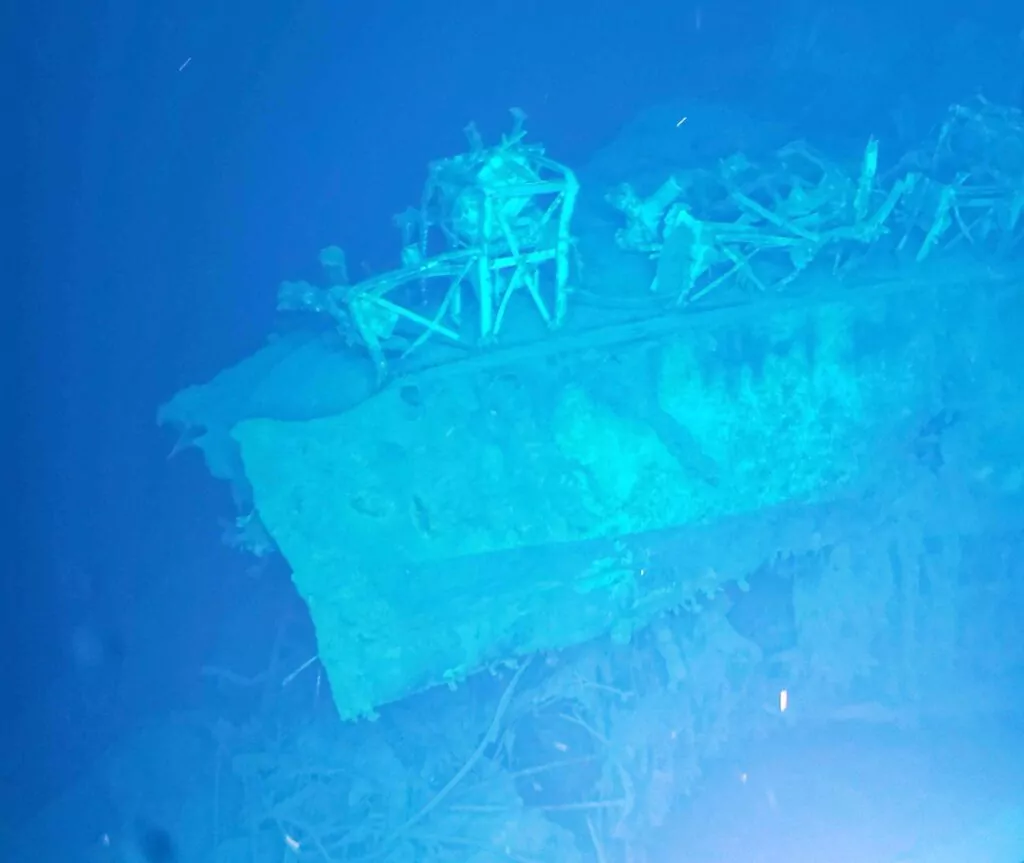
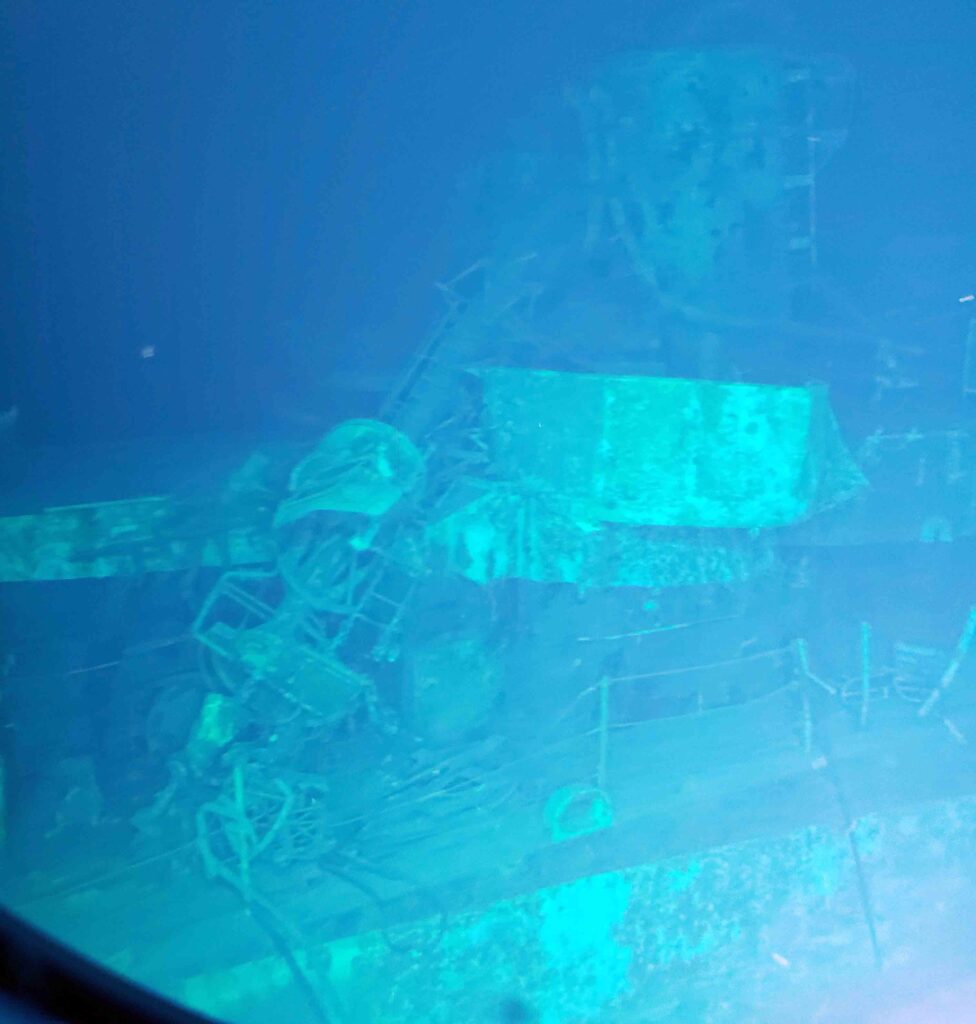
What was the first thing to catch his eye on approaching the Sammy B? “We came upon the port side midships and I saw the wreck of the mast, which was also a bit concerning because it had a lot of cables hanging from it and was just a mess.
“Immediately I got a very strong impression that this could be a bit of a dangerous wreck to survey, so let’s take this very slow and very cautiously… which we did.”
Enjoying unscuba-like bottom times must be a plus in such situations, I suggest. “Well, we do have some of it on battery power and that, to use a phrase, is our limiting factor, but we were able to find the wreck on that dive quite quickly, actually within 20 minutes of getting to the bottom, which was just extraordinary. That gave us several hours to really survey the wreck in its entirety.”
Vertical distance
It’s the end of the day on the Micronesian island of Guam, where Vescovo and his team are hanging out between expeditions, their mother ship Pressure Drop docked while they prepare for another series of 11km descents in the deepest place on Earth, Challenger Deep in the Pacific’s Mariana Trench. “I actually went into town, so got my feet on hard soil for two days, getting some rest and relaxation before we go out again,” he says.
A quick recap of Vescovo’s extreme adventures to date: he is the man who has visited, mapped and sampled the deepest points of all five oceans (along with other deep points) during the Five Deeps Expedition of 2018–2019. This included setting a world depth record of 10,928m and becoming the first person to dive Challenger Deep more than once.
He has also climbed the highest peak on each of the seven continents, and skied at least 100km at the last line of latitude at both the North and South Poles.
In 2019 he carried out the first submersible dive in 15 years to the Titanic. And Guinness World Records recognised his achievement of covering the greatest vertical distance without leaving Earth – the 19.77km between Everest’s top and Challenger’s bottom.
The Sammy B had been a major itch to scratch. “Since we went out to Samar two years ago, we were always interested in finding the Johnston and the Sammy B as well as the Gambier Bay, the whole lot, even the Japanese wrecks – whatever we could find. But right at the top of the list were the Johnston and Sammy B.”
The USS Johnston, also a Battle off Samar casualty, he had discovered and dived last April. At 6.45km down, it became the world’s deepest known wreck.
On the recent expedition attempts to find the Gambier Bay aircraft-carrier had not succeeded and the resting place of the other missing ship, the USS Hoel, remains a mystery. Would Vescovo try again for those two? “Well, I’d like to. It’s a question of resource availability, timing and all of that. All of these are privately funded expeditions and they are not inexpensive to conduct… but I’d love to to find all four.”
His achievements, he is keen to stress, are very much down to teamwork. There are the staff from his company Caladan Oceanic; EYOS Expeditions, which takes on the logistical challenge of mounting each operation; researchers such as maritime historian Parks Stephenson, whose work has been vital to many of the wreck discoveries; the Pressure Drop crew and more.
Expedition leader Kelvin Murray from EYOS is sitting in on our Zoom call in his Guam hotel to expand on this, but unfortunately relentless bursts of static render his attempts to contribute largely inaudible. “I’ve enjoyed listening to you,” he gets in ruefully to Vescovo following the interview.
“I’m sure you’ve had enough of that!” the other replies.
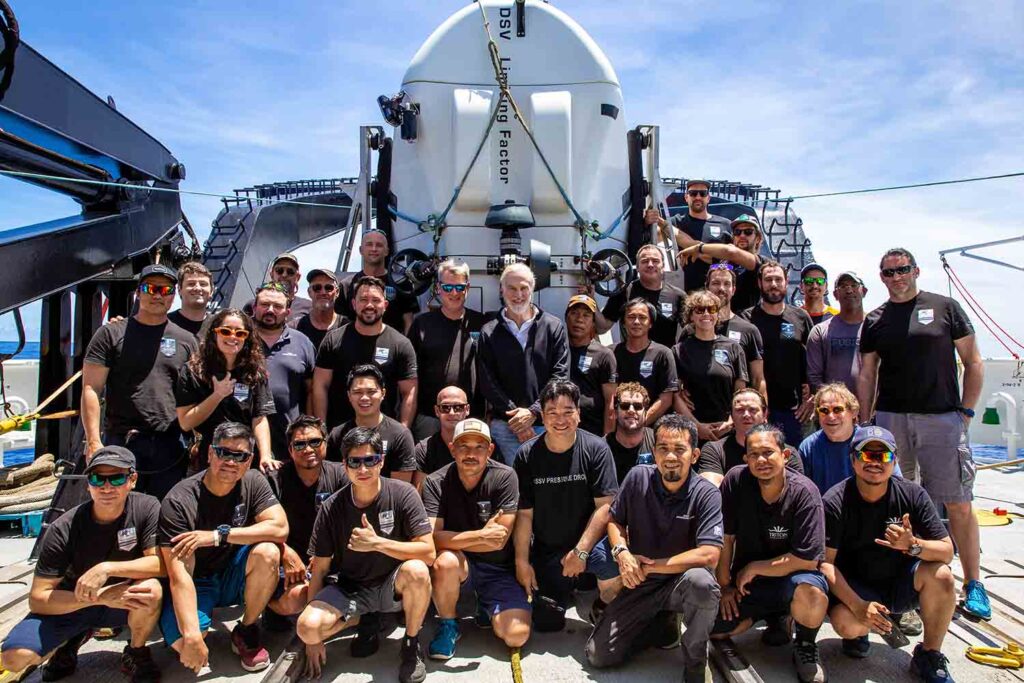
“Yeah, it definitely takes an enormous amount of resources to go on these expeditions looking for wrecks,” reflects Vescovo. “Even a destroyer-escort is tiny in the midst of the ocean, so it also takes an enormous amount of historical analysis and technical know-how and a great crew that’s able to dive the submersible and make repeated dives to 7000-ish metres. It was a great team effort that allowed us to make the success happen.”
Harsh environment
Of particular interest on the Sammy B expedition was the introduction of a new side-scan sonar developed by Deep Ocean Search to be carried by Limiting Factor. “The company I started, Caladan Oceanic, is a deep-ocean technology company more than anything else, and the construction of the Limiting Factor was of course the most noteworthy thing that we’ve done, but that also involves all the support infrastructure to develop technology that can go to the ultra-deep oceans.
“Given that 98% of the ocean is less than 6,000m deep, most commercial solutions are rated at less than that depth, so trying to find sonar that can operate below 6,000m wasn’t possible – it didn’t exist.
“To locate these wrecks we felt that we really did need a side-scan capability, but the normal way you find a wreck is to use an AUV to do large search patterns over 10-20 hours, back and forth. The problem with that is that if you go below 6,000m you need the entire vessel to be protected against that crushing depth, and that means the thrusters and the navigation system, not just the side-scan sonar.
“The big innovation with this device was that all we needed to do was to get the transducers mounted outside the submersible, get them rated for full ocean depth and everything else we put inside the submersible, which already had full ocean depth capability for navigation, propulsion all of that. And the pilot is the brain, of course.

“So in a way we built a hybrid that does allow you to have side-scan capability. It just has to be a manned submersible capable of going all the way to the bottom.”
The sonar has now proved itself at 6km, but was he confident that it would work at maximum ocean depth? “Well, we’ll find out in about two weeks! We’re going to try to take it down to the Challenger Deep with Dr Dawn Wright [chief scientist of geographical information systems company Esri]. I’m reasonably confident but, as I have learned, the ultra-deep ocean can be quite a harsh environment. It’s not very forgiving.”
Many setbacks
My next question, about whether the team has suffered many technological setbacks, is greeted with hearty laughter. “Oh my goodness, uh yes! We’ve have many technological setbacks. When you’re developing technology to repeatedly and reliably dive to the very bottom of the ocean and that will last for years, it seems that it’s been nothing but one technical challenge after another.
“I’ve personally been down to the bottom of the Challenger Deep 12 times with Limiting Factor and we’ve done even more dives than that in the other pools with other pilots, but the issue is to make it reliable.
“And to make something reliable under that incredible pressure, in freezing cold temperatures and corrosive salt water has been a real challenge, but we’ve just steadily overcome those issues. Now we believe we have a set of technology on the Limiting Factor that does indeed allow us, like this coming week, to dive three times to the bottom of the Challenger in five days.
“That’s what we’re planning, and no vehicle in history has ever had anywhere near that capability of reliability.”
Such rapid turnround times would have seemed unimaginable not so long ago, and again rely on a dedicated maintenance and development team of up to 12 specialists. “They’re responsible for making sure that everything on the submersible is good to go and making the repairs that are necessary – in fact they’re making suggestions after each dive based on analysing anything that didn’t go perfectly, and looking at how we can make it better.

“Theoretically we could do daily dives to full ocean depth – the issue is that we’re a bit cautious, and like to have a day of maintenance in between each dive, just to make sure that all the gaskets are good and everything is charged up properly and we can triple-check the submarine for safety.” Understandable.
The breakthrough side-scan sonar is only one of several recent enhancements designed to make Limiting Factor a more effective scientific tool. “We kinda had a wish-list and were able to knock down a lot of them. We added four more high-intensity lights on the top that allowed us to get those improved images on the Sammy B compared to those on the Johnston last year.”
A picture (below) of the triple torpedo tubes that confirmed the Sammy B’s identity shows the value of such lighting, though it was taken from only about a metre away, says Vescovo.
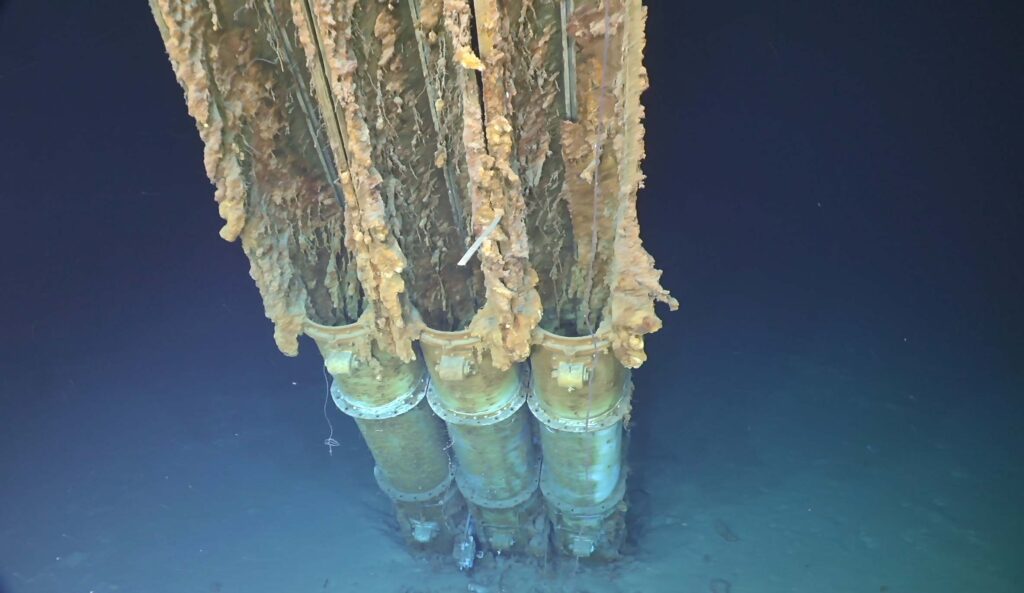
The team was also working on increasing the capability of Limiting Factor’s manipulator arm. “We have purchased and are developing some systems that allow us to program movements into the arm, so that it’s not completely reliant on the pilot to put things into a sample tray but can do that automatically,” he says.
Just a rock
Discovering wrecks is thrilling at any depth, but in that tall water column and in much of the deep ocean on mapping expeditions, Vescovo must be surrounded by what is essentially emptiness for hour after hour. Pursuing my naive line of enquiry, I ask if there is ever any danger of him getting bored down there.
“Oh no, my goodness, never get bored! It’s always exciting being in a submersible at 6 or 7,000 metres – but it can get a bit repetitive, I guess is a better word, when you’re just eager to find something new,” he concedes.
“But you always find small things on the seafloor, especially when you’re looking for a wreck. Even the most minor rock outcropping is going to get your interest because you don’t know, 80m away, if it’s a piece of wreckage or not.
“So you get excited and you go over and you get let down, because it’s just a rock, but you never know – that could be the first piece of wreckage that leads to a major wreck.”
On the last attempt to find the Gambier Bay “the team spent four hours on the bottom doing a search pattern and finding nothing, but you’re hoping that that one little hit on the sonar is the break that leads to an exciting discovery”.
I wondered whether Vescovo still found time to scuba dive and, if so, whether it now seemed either therapeutic or tame? “I haven’t gone scuba diving in several years since I had the Limiting Factor, which is where I’ve had to focus my time and resources, but I learnt to scuba dive in college and I’ve dived all over the world, starting in Monterey Bay [California] but also the Red Sea, the Bahamas and all those other places.
“It’s just a completely different experience but one that I very much enjoy. I particularly enjoy wreck diving. It’s never tame because scuba diving has its own dangers – you’re feeling the water, and you’re breathing through an apparatus, and the ocean is a dangerous place if you’re not careful.
“It actually feels safer and more like flying a plane when you’re in a submersible. In a way, scuba-diving is like the mountain-climbing of going into the ocean, and going into a submersible is like flying a high-performance jet. It’s just different, and I love both experiences.”
Science fiction
Born in 1966, Vescovo has enjoyed a golden career. He grew up in Dallas, Texas and gained an economics and political science degree from Stanford, a political science masters at MIT and an MBA from Harvard before becoming an intelligence officer in the US Navy Reserve for the 20 years up to 2013.
As a private investor, he accumulated the hard cash to fund the spectacular feats that brought him to fame (though I’ve been surprised by how many people still look blank when I mention his name. Underwater endeavour truly remains the invisible pastime, even in extreme form).
I wonder what his ambitions had been as a child. “I guess I was a little bit precocious but I loved science fiction and I loved maps, geography – I could sit for hours just looking at an atlas, so perhaps there was always a kernel of wanting to be an explorer.
“But, being a young kid, I guess I thought that everything had already been explored. Then, as I got older, I realised that there were places that were unexplored – it just took more resources and dedication to get to them.
“As a small child I wanted to be an astronaut. That’s what every little kid wanted to be, but I actually went into space this past month, so I’ve fulfilled that objective.” He had joined the crew of Blue Origin’s New Shepherd-21 on an 11-minute suborbital flight 7km beyond the traditional 100km “edge of space” – another day in an extraordinary life. “But you just make your opportunities, and I think I always had that desire to find new things.”
Switching between the deepest oceans, the highest mountains, the ends of the Earth and even into space, how easy is it to adjust your mindset? “I definitely get the impression that my mind is wired differently to that of most people. People tend to be mountain-climbers or they’re ocean people and I tend to do both, so I guess I was blessed with both proclivities.
“But to me they’re different halves of the same coin, they’re both extreme places that technology and training has allowed us to go to. You can’t climb Mt Everest unless you’ve got a lot of support equipment, great gear and oxygen, and you certainly can’t go to the bottom of the ocean without massive technological support, or go into space.
“So I just love being able to exploit what we do as humans, which is to build technology that will allow us to do things even though Nature says we have no business going to those places. I love testing myself along multiple axes, not just one – I think that’s part of being a human.”
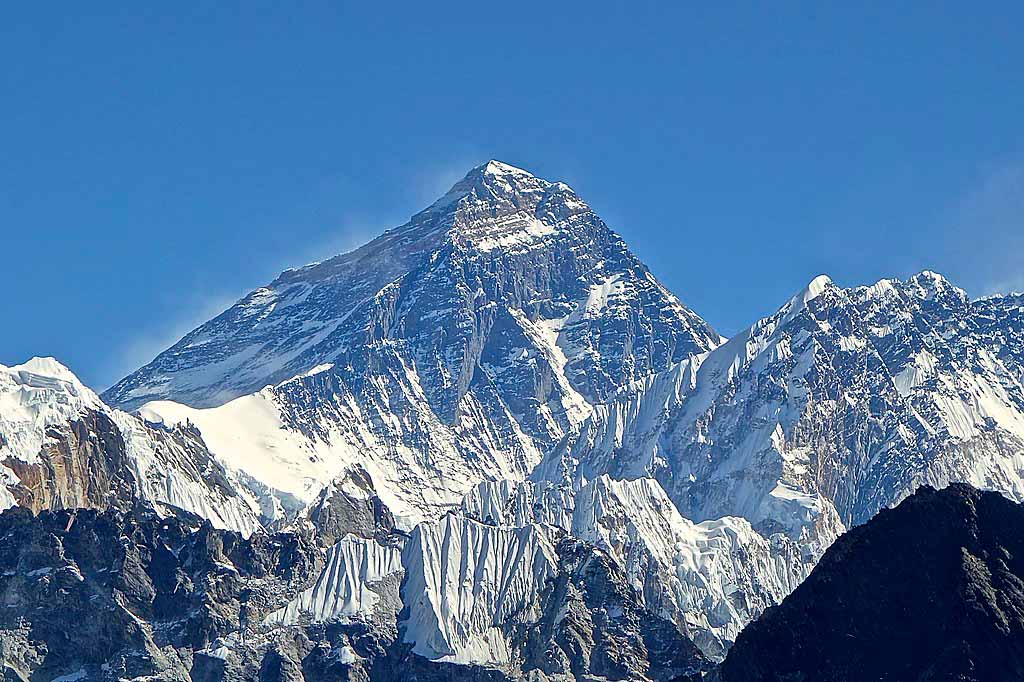
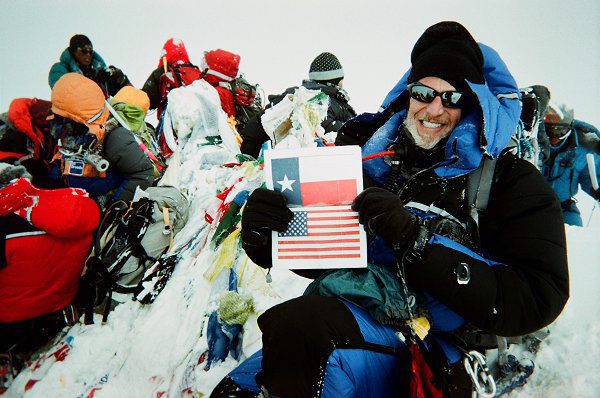
I’ve seen photos of the hordes of climbers queuing to reach the peak of Mt Everest, and observe that he must have found that location a marked contrast to the solitude of the deep ocean. I’m wrong.
“Actually it’s funny you mention that – on the day that I summited Everest in 2010 it was a unique circumstance, where on the night that we were going to ascend we actually had a bit of a storm and we almost didn’t launch. But it was right on the limit of what we could climb and we had a very strong team, so we decided to go ahead and ascend.
“The benefit of that was that there was virtually no one on the mountain. The downside was that it was very cold and a bit more dangerous than usual because we were in a storm, and we had pledged that if it ever got worse we would turn around.
“It never really got worse, but it never really got better. What that meant was that we could just keep going, because there was no one in our way. It just took a little bit more out of us to climb in those conditions.” I might have known.
I still find it interesting that when later asked to select a standout achievement he thinks of Everest, one shared with so many other people, first.
“It was such an incredible mental and physical challenge in beating it, frankly, and accomplishing that felt viscerally incredibly satisfying. But in a similar vein – but different – designing, building and piloting Limiting Factor to the deepest points of all five oceans was also extremely rewarding. No one had even tried to do that.”
Busy summer
The submersible’s next venture will be three dives at Challenger Deep, to expand the area investigated last year with representatives of the sponsors of these scientific missions sitting beside him. Such sponsorship is vital: “The funds that they provided allowed me to go to find the Samuel B Roberts, and they will help fund the science expeditions I’ll be doing later in the year with other individuals,” says Vescovo.
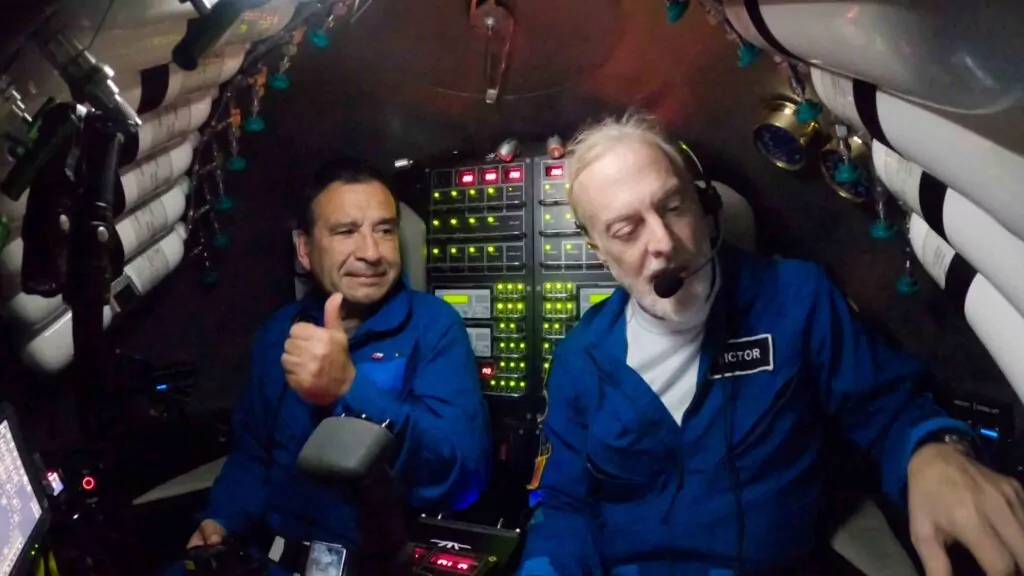
“After that we’ll do the first crewed descents of the Yap and Palau trenches. In fact I’ll be taking the former president of Palau to the bottom of the Palau trench, which has never been done. Involving the scientific and other people from the local communities when going down to their trenches is, I think, completely appropriate.”
Then in August Vescovo takes part in an expedition to dive all the deep – 8-9km – Japanese trenches “that have never seen a crew descend to their very bottom. We’ll be doing three of those and that will be a big scientific endeavour. Yes, we’re going to be very busy this summer.”
Sand in the ointment has been Vescovo’s discovery that even the Earth’s deepest places are not safe from human pollution. “I found a piece of debris at the bottom of the Challenger Deep on my very first dive,” he says. “I actually haven’t seen any since except for discarded ROV tethers, primarily from Chinese vessels, I believe, but also from Japanese and even American ones.
“The greatest amount of pollution I found in Challenger Deep has been from scientific expeditions, which is kind of tragic. But I have seen quite a bit of pollution in the Mediterranean and more in the temperate latitudes, certainly a lot in the Philippine Trench, not so much in the Polar latitudes, thank goodness.
“But unfortunately wherever we’ve taken water samples we’ve found evidence of microplastics, and that’s the real pernicious danger, because once plastics get into the ocean and break down into microplastics, there’s no getting it out.”
Vescovo’s halcyon days of deep ocean exploration appear to be approaching a crossroads. He announced a while back that, having developed and proven his set-up, he was hoping to find a government, an organisation or a very deep-pocketed individual willing to fund it 24/7 for scientific research.
“While I have some degree of means, I don’t have the personal capability to fund a ship and a submersible of this calibre constantly, indefinitely,” he admits. “I am hopeful that in the next six to 12 months I will find a potential buyer that could actually fund it in such a way that it can continue its scientific efforts.”
Would Vescovo remain as pilot? “I don’t know, that would be subject to negotiation. But even if I did not, I would still be deeply involved in the ocean community. I would undertake efforts to work with ROVs or shallower-diving submersibles or even, maybe in a couple of years, try to develop a successor to the Limiting Factor, and use all the lessons that we’ve learned in this development to make something even better.”
But, of course, he would miss what he has now. “Of course I would – it’s part of my life!”
Also on Divernet: Vescovo Dives World’s Deepest Shipwreck Sammy B, World’s Deepest Diver Cracks Atacama Trench, First Humans Dive Into Emden Deep, History Made With Deepest Wreck Dive, Vescovo Becomes Deepest Diver – By 16m, Son Follows Father On Deepest Dive, Deepest-Dive Dream Comes At A Price
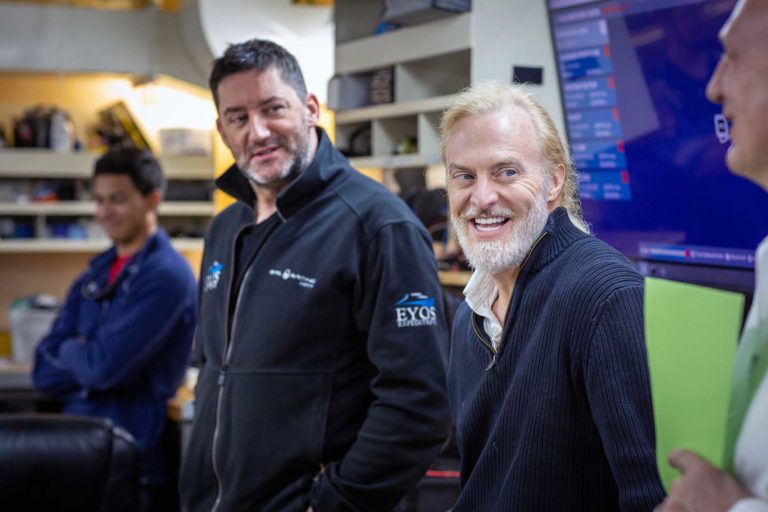

My gratitude and best wishes to Victor Vescovo and team for everything you are doing. My Father was aboard the USS Gambier Bay. He survived the sinking and is now deceased. I am his proud daughter and heard him tell the stories of the battle and his experience of it all. My hope is to some day set eyes on his ship he so proudly spoke of. It was always thought it would never be found but with the success of past dives I am very hopeful. Thank you for your work. It is very much appreciated.